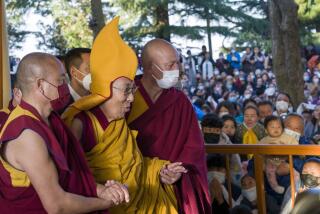Panchen Lama, Tibet’s No. 2 Spiritual Leader, Dies at 50
- Share via
BEIJING — The Panchen Lama, the second most senior Tibetan religious leader, died Saturday at the age of 50 after suffering a stroke, the New China News Agency reported today.
It said he died at his residence in Xigaze, Tibet, where he was presiding over the opening ceremony of a rebuilt shrine.
The agency said the Panchen Lama had been fatigued because of his duties at the opening of the shrine, which contains the remains of the fifth to ninth Panchen Lamas. It gave no additional details.
State television showed the Panchen Lama, a portly man, performing the leading role at Saturday’s opening, assisted by monks in light red robes.
He was the most senior Tibetan in the Chinese government, as vice chairman of the standing committee of the National People’s Congress, the country’s Parliament.
The Panchen Lama had long been a voice opposing Tibetan independence, supporting secular development and promoting the survival of some Tibetan religious traditions. Recently he was involved in delicate contacts between China and the still-exiled Dalai Lama, 53.
Tibet has been rocked by three major pro-independence demonstrations in the last 16 months, each of which ended with police firing into crowds of protesters.
The region has sometimes been part of the Chinese empire and sometimes independent. It had de facto independence from 1911, when the Qing Dynasty collapsed, until 1951, when the Communists reimposed Chinese control.
Question of Loyalty
The fundamental issue that had divided the Panchen Lama and the Dalai Lama is whether Tibet owes loyalty to all of China or only to Tibet.
The Dalai Lama, Tibet’s supreme spiritual leader, fled to exile in India in March, 1959, after a hopelessly outgunned revolt against Chinese rule broke out in Lhasa, Tibet’s capital.
Three weeks later, the Panchen Lama walked on stage at a Lhasa meeting hall to the thunderous applause of pro-Beijing Tibetan and Chinese cadres.
He had cast his lot with China.
At a press conference last year, the Panchen Lama said that after the crushing of the 1959 rebellion, he supported the imposition of radical change in Tibet.
“It was I who asked the central government to carry out democratic reforms,” he said.
The Panchen Lama was born in February, 1938, in a small village near the northeastern edge of the Tibetan-Qinghai plateau. By tradition, reincarnations of both the Dalai Lama and the Panchen Lama are discovered by religious elders searching among boys after the previous leader’s death. The Panchen Lama was selected in 1941 as one of several boys believed to be the possible reincarnation of the ninth Panchen Lama, who died in 1937.
He was sent for training at a monastery, and in 1949, he was installed as the 10th Panchen Lama. This was done with the backing of China’s central government, then controlled by the Nationalist Party.
The Panchen Lama became a target of “internal criticism” in 1962, was publicly attacked in 1964 and then, shortly after Chairman Mao Tse-tung launched the decade-long Great Proletarian Cultural Revolution in 1966, he was imprisoned. He spent almost 10 years in confinement, and for much of this period, the outside world assumed that he was dead.
Upon his release he was gradually restored to a number of largely honorary positions, including the vice chairmanship of the Standing Committee of the National People’s Congress.
As a National People’s Congress leader, he assumed growing visibility as a spokesman for China’s policy in Tibet, which seeks to combine a limited revival of religious freedom with an absolute ban on pro-independence activities.
For most of his recent years he lived in Beijing, visiting Tibet only occasionally, and remained an enigmatic figure. According to foreign press reports and rumors that circulate in Tibet and Beijing, he was married--in violation of celibacy rules--and had a daughter.
More to Read
Sign up for Essential California
The most important California stories and recommendations in your inbox every morning.
You may occasionally receive promotional content from the Los Angeles Times.













